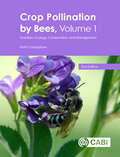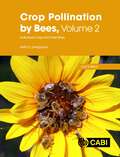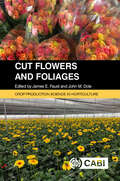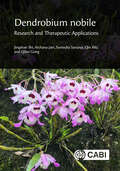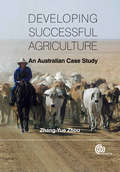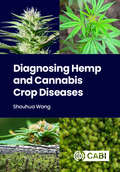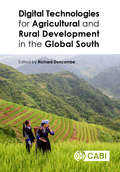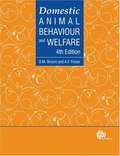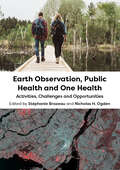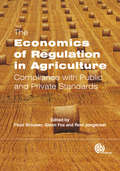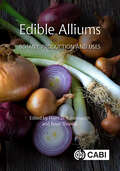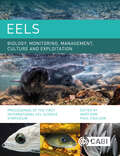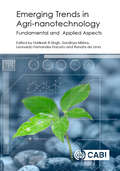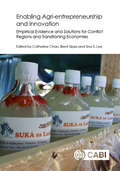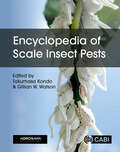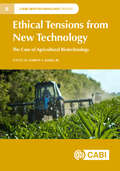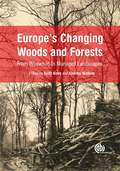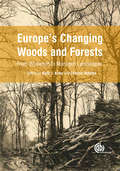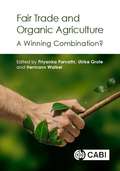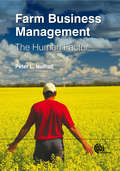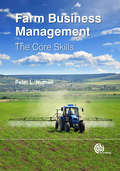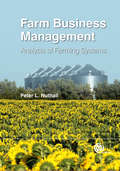- Table View
- List View
Crop Pollination by Bees, Volume 1: Evolution, Ecology, Conservation, and Management
by Dr Keith DelaplaneSince the second half of the 20th Century, our agricultural bee pollinators have faced mounting threats from ecological disturbance and pan-global movement of pathogens and parasites. At the same time, the area of pollinator-dependent crops is increasing globally with no end in sight. Never before has so much been asked of our finite pool of bee pollinators. This book not only explores the evolutionary and ecologic bases of these dynamics, it translates this knowledge into practical research-based guidance for using bees to pollinate crops. It emphasizes conserving wild bee populations as well as culturing honey bees, bumble bees, and managed solitary bees. To cover such a range of biology, theory, and practice from the perspectives of both the pollinator and the crop, the book is divided into two volumes. Volume 1 focuses on bees, their biology, coevolution with plants, foraging ecology and management, and gives practical ways to increase bee abundance and pollinating performance on the farm. Volume 2 (also available from CABI) focuses on crops, with chapters addressing crop-specific requirements and bee pollination management recommendations. Both volumes will be essential reading for farmers, horticulturists and gardeners, researchers and professionals working in insect ecology and conservation, and students of entomology and crop protection.
Crop Pollination by Bees, Volume 2: Individual Crops and their Bees
by Dr Keith DelaplaneSince the second half of the 20th Century, our agricultural bee pollinators have faced mounting threats from ecological disturbance and pan-global movement of pathogens and parasites. At the same time, the area of pollinator-dependent crops is increasing globally with no end in sight. Never before has so much been asked of our finite pool of bee pollinators. This book not only explores the evolutionary and ecologic bases of these dynamics, it translates this knowledge into practical research-based guidance for using bees to pollinate crops. It emphasizes conserving wild bee populations as well as culturing honey bees, bumble bees, and managed solitary bees. To cover such a range of biology, theory, and practice from the perspectives of both the pollinator and the crop, the book is divided into two volumes. Volume 1 focuses on bees, their biology, coevolution with flowering plants, foraging ecology and management, and gives practical ways to increase bee abundance and pollinating performance on the farm. Volume 2 (this volume) focuses on crops, with chapters addressing crop-specific requirements and bee pollination management recommendations. Both volumes are essential reading for farmers, horticulturists and gardeners, researchers and professionals working in insect ecology and conservation, and students of entomology and crop protection.
Cut Flowers and Foliages (Crop Production Science in Horticulture)
by Raul I Cabrera Elizabeth Cieniewicz Melissa Muñoz Henry WainwrightThe cut flower and foliage industry is a global business with major production locations in North America, South America, Central America, East Africa, Europe, the Middle East, Asia, Australia and New Zealand. Few other horticulture crops are as ubiquitous, yet the production techniques and challenges are universal. This book describes the main international production locations and markets, including current trends and directions. The focus is on production in protected cultivation. The major species - including rose, chrysanthemum, carnation, orchid and gerbera - dominate the global market and these are individually explored in detail. Specialty species and cut foliages are also addressed, as well as significant details of production, including irrigation and fertilization, disease and disease management, and biological control of pests. Finally, the postharvest chapter covers details of harvesting, transporting and delivering high quality flowers that provide an excellent vase life. Highly illustrated with color photos throughout, this is an essential resource for students and researchers in horticulture, growers and producers, and those in the floriculture industry.
Dendrobium nobile: Research and Therapeutic Applications
by Professor Jingshan Shi Dr Archana Jain Dr Surendra Sarsaiya Professor Qin Wu Prof Qihai GongDendrobium nobile, a species of orchid native to South-east Asia, has been revered in traditional medicine systems for centuries due to its medicinal properties and therapeutic benefits. With a rich history in Chinese medicine and other traditional healing practices, there is now much interest in the chemical constituents of this orchid and potential applications for various health conditions. The aim of this book is to bridge the gap between the traditional knowledge surrounding this remarkable plant and the cutting-edge scientific investigations that have shed light on its pharmacological activities. It includes: · An overview of Dendrobium nobile, exploring its historical use in traditional medicine and its significance in various cultures. · Information on the chemical constituents, pharmacological activities, antioxidant properties and potential role in alleviating pain, inflammation, and respiratory diseases. · Therapeutic applications: immune enhancement, management of chronic conditions like diabetes and cardiovascular issues, gastrointestinal disorders, renal diseases, neuroprotection and skin health. · Safety and toxicity issues. · Sustainable practices and conservation of Dendrobium nobile, and the importance of preserving biodiversity.
Developing Successful Agriculture
by Zhang-Yue ZhouAgriculture remains an important industry to both developed and developing economies. Unfortunately, many developing countries are still suffering from a lack of agricultural growth, especially those in Africa and South Asia. Australia's agricultural system has developed from almost non-existence 220 years ago to one of the most advanced and efficient in today's world. It is also one of the least distorted, receiving little government assistance. This book provides an updated and comprehensive account of a successful agricultural story, which can stimulate policy makers, researchers, agribusiness consultants and students to relate the Australian experience to their own agricultural development.
Diagnosing Hemp and Cannabis Crop Diseases
by Dr Shouhua WangHemp and cannabis, both belonging to Cannabis sativa, have emerged as some of the most valuable crops because of their multiple functionalities - industrial, medicinal, and recreational uses. Like all other crops, they are at risk of diseases and pests. In certain cases, an entire hemp field can fail due to unexpected disease. As a new and highly regulated crop, research on Cannabis crop diseases is scarce, and the science of plant diagnostics is not well covered in the literature. Taking hemp/cannabis as a model crop, the book illustrates how to diagnose a disease problem and how to manage it effectively. It presents real disease cases encountered during crop production, and explains methods of diagnosis, both in the field and in the lab, in order to find out the cause(s). The book provides: ·A field and laboratory guide to diagnosing hemp and cannabis diseases and pest problems ·Ready-to-adopt skills, methods and protocols in plant diagnosis, which can be applied to other crops ·Over 300 colour photographs accompanied by a wealth of disease information, including field observations, unique symptoms, microscopic details, and molecular data. This book is essential for anyone who is interested in learning about Cannabis crop diseases, for crops grown in the field, and in indoor production facilities.
Digital Technologies for Agricultural and Rural Development in the Global South
by Richard DuncombeThis book shares research and practice on current trends in digital technology for agricultural and rural development in the Global South. Growth of research in this field has been slower than the pace of change for practitioners, particularly in bringing socio-technical views of information technology and agricultural development perspectives together. The contents are therefore structured around three main themes: sharing information and knowledge for agricultural development, information and knowledge intermediaries, and facilitating change in agricultural systems and settings. The book includes: -Views from diverse academic disciplines as well as practitioners with experience of implementing mobile applications and agriculture information systems in differing country contexts. -Case studies from a range of developing countries and information from across the public and private sector. -A set of practitioner guidelines for successful implementation of digital technologies. With contributions reaching beyond just a technological perspective, the book also provides a consideration of social and cultural factors and new forms of organization and institutional change in agricultural and rural settings. An invaluable read for researchers in international development, socio-economics and agriculture, it forms a useful resource for practitioners working in the area.
Domestic Animal Behaviour and Welfare, 4th edition
by Donald Broom Andrew FraserBehaviour is a significant indicator of health in animals and understanding behaviour is the key to good management. Animal behaviour and animal welfare science are fast becoming core topics in the curriclua of agriculture and veterinary students. The eagerly awaited fourth edition of Farm Animal Behaviour and Welfare builds on the coverage of the previous edition, fully updating it to take into account developments over the last 10 years. This new edition covers companion animals as well as farm animal species including farmed fish. It is an indispensible textbook covering the major and growing areas in agricultural and veterinary science and practice.
Earth Observation, Public Health and One Health: Activities, Challenges and Opportunities
by Brazeau Stéphanie Nicholas H. OgdenThis book reviews the contributions of Earth Observation (EO) to public health practices. It examines how EO is being used to understand, track, predict, and manage infectious and chronic diseases, and it provides discussion on the current challenges and the significant development potential of EO to a One Health approach. Its objective is to address a set of questions: How does EO currently assist public health activities? What are the challenges for operational use of EO in public health? What are the opportunities for EO to benefit public health in the near future? This review concentrates on the following priority themes to which EO and geomatics can make important contributions: mosquito-borne and tick-borne diseases; water-borne diseases; air quality and extreme heat effects; and geospatial indicators of vulnerable human populations. EO has also demonstrated potential during the COVID-19 pandemic as an efficient provider of data on rapid environmental and socio-economic changes and impacts. Remotely sensed data are particularly useful for risk modelling and mapping projects to help generate information on occurrence and spatio-temporal trends of disease risk. Similarly, EO can be used to identify risk factors for disease risk or emergence detected in surveillance, and support development of early warning systems. Risk maps enable public health professionals to anticipate and prepare for health threats, and they can support responses to infectious disease epidemics or existing endemic conditions. This book emerged from the collaboration of the Public Health Agency of Canada and the Canadian Space Agency with contributions of international experts. Their findings will be of great value to public health and EO professionals interested in developing and applying geospatial applications in the risk assessment and management of public health issues.
Economics of Regulation in Agriculture
by Consuelo Varela-Ortega Roel Jongeneel Floor Brouwer Alfons Weersink Jon Winsten Glenn Fox Anton Meister Irina Bezlepkina Vicki Swales Silvia De Miranda Kaley Hart Kees De RoestThis work debates and investigates the cross-compliance system - whereby farmers comply with certain standards relating to the environment, food safety and animal and plant health. It discusses cross-compliance in the context of existing standards, on-farm costs and the competitiveness of farm businesses. Analysing the economics of regulation both within the internal market of the EU and the broader world market by examining a broad range of agricultural products. This resource will be of value to agriculture and resource economists, policy makers, researchers and students in environmental and agricultural policy and modelling.
Edible Alliums: Botany, Production and Uses (Botany, Production and Uses)
by Brian Thomas Haim D. RabinowitchAllium crops include more than 30 species, many of which (for e.g. onions, shallots, garlic, leeks, bunching onions, and chives) are of economic importance. Bulb onions rank second only to tomatoes in terms of global production. Alliums are farmed and harvested in a range of climatic conditions worldwide, forming important parts of local diets. This book provides a comprehensive review of major and minor Allium crops from scientific and horticultural perspectives. It broadly covers modern biology (including genetics and breeding), propagation, production, processing, and nutritional and health benefits. Edible Alliums contains coverage of: Both major and minor Allium crops. Improving crop production, quality, and sustainability of Allium crops. Advances in digital technologies, 'omics' research and gene editing. Objectives for improving crop performance, such as integrated crop management, the plant-soil interface, improving propagation materials, post-harvest quality and reducing waste. This is an essential resource for scholars, researchers and students in plant science and agriculture, in addition to molecular biologists, plant breeders, agronomists, consultants, and extension specialists.
Eels Biology, Monitoring, Management, Culture and Exploitation: Proceedings of the First International Eel Science Symposium
by Andy Don; Paul CoulsonThe freshwater eels, the Anguillids, have increasingly become the focus of attention for fisheries managers, scientists, researchers, policy makers, conservation bodies and other stakeholders. These species can be seen as a bellwether for issues affecting aquatic ecosystems - their steep decline and the management initiatives to try and reverse this trend, touch on subjects as diverse as disconnected waterways, loss of habitat, novel parasites, pollution, over-fishing and climate change. There are some 16 species of the Anguilla genus and all exhibit similar lifestyles, growing in waters often far-removed from their marine spawning grounds. These enigmatic, contradictory and confounding species share similar challenges and pressures wherever they are found. This book was generated from the 1st UK International Eel Science Symposium, which was held at the Zoological Society of London (ZSL) in June 2017. Hosted by the Institute of Fisheries Management (IFM), the ZSL and the Environment Agency (EA), the Symposium was heralded as a success, with over 180 delegates in attendance. Many of the world's top eel specialists attended or gave presentations across a diverse range of subjects. This was one of the Symposium's, and now the book's great strengths - its diversity of subjects and authors. Many countries are represented within the book, from across Europe and as far afield as New Zealand, South Africa, Vanuatu, French Polynesia, Japan, Canada and the USA. The EA and IFM have collaborated to produce this landmark book, which includes a mix of cultural, scientific and management information that will be invaluable to anyone with a professional or personal interest in these mysterious fish, including ichthyologists, fisheries scientists and managers, aquaculture personnel, environmental biologists and ecologists, marine and freshwater biologists, vertebrate zoologists, animal behaviourists and students studying in all these areas. Libraries in all universities and research establishments where these subjects are studied and taught should have copies on their shelves.
Emerging Trends in Agri-Nanotechnology: Fundamental and Applied Aspects
by Xiaodong Yang Mahendra Rai Jyoti Singh Kelvii Wei Kelvii Wei Harikesh Bahadur Singh Prachi Singh Sandhya Mishra Surendra Singh Semih Otles Dr Birinchi Sarma Manoj Kumar Chitara Gagan Kumar Anupam Maharshi Amina Antonacci Marcelo Dutra Arbo Fabiana Arduini Daiana Silva Avila Carolina Castro Bueno Estefania V Campos R K Chaturvedi Deepika Chauhan Sampa Das Jhones L Oliveira Dr Renata De Lima Kunzes Dolma Carolina Alves Santos Professor Leonardo Fernandes Fraceto Aniket Gade Solange Cristina Garcia Renato Grillo Indarchand Gupta Janmejay Pandey Mauricio Tavares Jacques Akansha Jain S Marimuthu Vijay Kumar Mishra Arpan Mukherjee Jessica Nardi Raksha Pandit Jai Singh Patel K Raja Rahul Singh Rajput Ratul Moni Ram Indira Rathore Buket Yalcin Sahyar Viviana Scognamiglio N N Singh Amira S Soliman Ankit Srivastava Arohi Srivastava K S Subramanian J C Tarafdar Sudheer K YadavThe science of nanotechnology, the manipulation, design and engineering of devices at the atomic and molecular scale, is starting to be applied to many disciplines including aspects of agriculture and crop science. This book opens with a brief history of nanotechnology in agriculture. Applications are then examined in detail, including nanopesticides, nanosensors, nanofertilizers, and nanoherbicides. Topics covered include; the biosynthesis of nanoparticles (through microbes, plants and other biotic agents); the ecological consequences of their delivery into the environment (examining effects and toxicity on soil, soil biota, and plants); safety issues; an overview of the global market for nanotechnology products, and the regulation of nanotechnology in agriculture. The book concludes with speculations on what the future holds for the technology. The book has been written by an international group of researchers and experts from over 12 countries with experience across a wide range of issues relating to the industry. This book will be of use to a wide range of researchers and professional scientists in the agricultural sector, academia and industry, including microbiologists, chemical engineers, geneticists, plant scientists and biochemists.
Emerging Trends in Agri-nanotechnology: Fundamental And Applied Aspects
by Harikesh B. Singh Sandhya Mishra Leonardo Fernandes Fraceto Renata De LimaThe science of nanotechnology, the manipulation, design and engineering of devices at the atomic and molecular scale, is starting to be applied to many disciplines including aspects of agriculture and crop science. This book opens with a brief history of nanotechnology in agriculture. Applications are then examined in detail, including nanopesticides, nanosensors, nanofertilizers, and nanoherbicides. Topics covered include; the biosynthesis of nanoparticles (through microbes, plants and other biotic agents); the ecological consequences of their delivery into the environment (examining effects and toxicity on soil, soil biota, and plants); safety issues; an overview of the global market for nanotechnology products, and the regulation of nanotechnology in agriculture. The book concludes with speculations on what the future holds for the technology. The book has been written by an international group of researchers and experts from over 12 countries with experience across a wide range of issues relating to the industry. This book will be of use to a wide range of researchers and professional scientists in the agricultural sector, academia and industry, including microbiologists, chemical engineers, geneticists, plant scientists and biochemists.
Enabling Agri-entrepreneurship and Innovation
by Catherine Chan Brent Sipes Tina S. LeeAgricultural entrepreneurs in conflict and post-conflict regions face special challenges; not just everyday personal risks, but also the difficulties of building small businesses when real or threatened violence can disrupt business growth cycles and economic security. Alongside establishing secure institutions, building a secure economy is rightly seen as the best way for conflict-torn regions to establish a peaceful future. But current agricultural entrepreneurship training and development starts from an assumption of peace, meaning that it is not always fit for purpose. The result is sub-optimal program design and inefficient use of resources. A product of a collaboration of experts in the fields of agri-business, agricultural marketing, and international development, this book gives officials and agencies developing entrepreneurship programs the practical real-life examples they need. Key Features: #65533; Based on research by experienced field practitioners. #65533; Establishes best practice approaches for supporting agri-entrepreneurship in conflict regions. #65533; Range of global case studies to illustrate lessons learnt.
Enabling Agri-entrepreneurship and Innovation: Empirical Evidence and Solutions for Conflict Regions and Transitioning Economies
by Jacqueline Jacqueline Bikash Bikash Maurizio Canavari James R. Hollyer Anera Alishani Jovelyn Bantilan Emilie Bayona Domenico Dentoni Ekrem Gjokaj Muje Gjonbalaj Drini Imami Cynthia Lai Kathleen Liang Rusyan Jill Mamiit Lusille Mission Elma Neyra Michelle Ragocos Ortez Mary M. Pleasant Klodjan Rama Pauline Sullivan Bir Bahadur Tamang Katherine A. Wilson Edvin ZhllimaAgricultural entrepreneurs in conflict and post-conflict regions face special challenges; not just everyday personal risks, but also the difficulties of building small businesses when real or threatened violence can disrupt business growth cycles and economic security. Alongside establishing secure institutions, building a secure economy is rightly seen as the best way for conflict-torn regions to establish a peaceful future. But current agricultural entrepreneurship training and development starts from an assumption of peace, meaning that it is not always fit for purpose. The result is sub-optimal program design and inefficient use of resources. A product of a collaboration of experts in the fields of agri-business, agricultural marketing, and international development, this book gives officials and agencies developing entrepreneurship programs the practical real-life examples they need. Key Features: · Based on research by experienced field practitioners. · Establishes best practice approaches for supporting agri-entrepreneurship in conflict regions. · Range of global case studies to illustrate lessons learnt.
Encyclopedia of Scale Insect Pests
by Helen Harman Jan H. Giliomee Jocelyn A. Berry Manuela Branco Lyle Buss Mr Alejandro Caballero Mr Juang Horng Chong Lucía E. Claps C. De Klerk Rodrigo Diaz Imre Foldi Antonio P. Garonna Ilya A. Gavrilov-Zimin Raymond J. Gill Penny J. Gullan Disna N. Gunawardana Sunil Joshi M. Bora Kaydan Paris L. Lambdin Yen-Po Lin Christopher Malumphy Zvi Mendel Vitor Cezar Pacheco da Silva Giuseppina Pellizzari Ana Lúcia Peronti Francesco Porcelli Alex Protasov Ting-Kui Qin Andrea Amalia Ramos Portilla Dewi Sartiami Scott A. Schneider U.G.A.I. Sirisena Pompeo Suma Éva Szita Hirotaka TanakaScale insects feed on plant juices and can easily be transported to new countries on live plants. They sometimes become invasive pests, costing billions of dollars in damage to crops worldwide annually, and farmers try to control them with toxic pesticides, risking environmental damage. Fortunately, scale insects are highly susceptible to control by natural enemies so biological control is possible. They have unique genetic systems, unusual metamorphosis, a broad spectrum of essential symbionts, and some are sources of commercial products like red dyes, shellac and wax. There is, therefore, wide interest in these unusual, destructive, beneficial, and abundant insects. The Encyclopedia of Scale Insect Pests is the most comprehensive work on worldwide scale insect pests, providing detailed coverage of the most important species (230 species in 26 families, 36% of the scale insect pest species known). Advice is provided on collection, preservation, slide-mounting, vouchering, and labelling of specimens, fully illustrated with colour photographs, diagrams and drawings. Pest species are presented in two informal groups of families, the 'primitive' Archaeococcoids followed by the more 'advanced' Neococcoids, covered in phylogenetic order. Each family is illustrated and diagnosed based on features of live and slide-mounted specimens, with information on numbers of genera and species, main hosts, distribution, and biology. For the important pest species, coverage includes information on the morphology of live and slide-mounted specimens, common names, principal synonyms, geographical distribution, plant hosts, plant damage and economic impact, reproductive biology, dispersal, and management strategies including biological, cultural and chemical control, sterile insect techniques, regulatory control, early warning systems and field monitoring. An additional complete list of scale insect pests worldwide is provided, comprising 642 species in 28 scale insect families (about 8% of the 8373 species of living scales known), with information on plant hosts, geographical distribution and validation sources. Beneficial uses of scale insects include sources of red dyes, natural resins and waxes, and agents for invasive weed control, alongside the importance of their honeydew to bees for making honey, and as a food source to other animals. Academic researchers, students, entomologists, pest management officials in agribusiness or government including plant quarantine identifiers, extensionists, farmers, field scientists and ecologists will all benefit from this book.
Ethical Tensions from New Technology: The Case Of Agricultural Biotechnology (Plant Science / Horticulture Ser. #6)
by Jr. Harvey S. JamesThe introduction of new technologies can be controversial, especially when they create ethical tensions as well as winners and losers among stakeholders and interest groups. While ethical tensions resulting from the genetic modification of crops and plants and their supportive gene technologies have been apparent for decades, persistent challenges remain. This book explores the contemporary nature, type, extent and implications of ethical tensions resulting from agricultural biotechnology specifically and technology generally. There are four main arenas of ethical tensions: public opinion, policy and regulation, technology as solutions to problems, and older versus new technologies. Contributions focus on one or more of these arenas by identifying the ethical tensions technology creates and articulating emerging fault lines and, where possible, viable solutions.
Europe's Changing Woods and Forests
by Peter Buckley Charles Watkins Juha Siitonen John Fletcher Peter Savill Robert Robert Diego Moreno Chris Quine Xavier Rochel Jim Latham Tibor Hartel Emma Goldberg Thomas Ranius Per Anglestam Matthias Bürgi Tomasz Samojlik George Peterken Keith Kirby Roberta Cevasco Robert Hearn Martin Hermy Clive PotterOur understanding of the ecological history of European forests has been transformed in the last twenty years. Bringing together key findings from across the continent, this book provides a comprehensive account of the relevance of historical studies to current conservation and management of forests. It combines theory with a series of regional case studies to show how different aspects of forestry play out according to the landscape and historical context of the local area.
Europe's Changing Woods and Forests: From Wildwood to Managed Landscapes
by Peter Buckley Juha Siitonen John Fletcher Peter Savill Robert Robert Diego Moreno Chris Quine Xavier Rochel Jim Latham Tibor Hartel Emma Goldberg Thomas Ranius Per Anglestam Matthias Bürgi Tomasz Samojlik George Peterken Roberta Cevasco Robert Hearn Martin Hermy Clive PotterOur understanding of the historical ecology of European forests has been transformed in the last twenty years. Bringing together key findings from across the continent, Europe's Changing Woods and Forests: From Wildwood to Managed Landscapes provides a comprehensive account of recent research and the relevance of historical studies to our current conservation and management of forests. Combining theory with a series of regional case studies, this book shows how different aspects of forestry play out according to the landscape and historical context of the local area, with broad implications for woodland history, policy and management. Beginning with an overview of Europe's woods and forests, the book reviews a variety of management techniques (including wood-pastures, coppicing, close-to-nature forestry and the impact of hunting), describes how plants and animals respond to changes in woodland and forest cover, and includes case histories from around the continent. It concludes with a discussion of how lessons learned from the past can help in the future. This book is both a vital resource and an interesting read for foresters, conservationists, landscape historians, geographers and ecologists.
Fair Trade and Organic Agriculture
by Priyanka Parvathi Ulrike Grote Hermann WaibelThe markets for organic and fair trade certified commodities are growing rapidly, with environmentally sound and more equitable certification systems likely to offer benefits for both small-scale farmers and society at large. Despite much debate about their contribution to sustainability, there has been little scientific analysis, so it is vital to assess if it is technically and economically feasible to meet growing consumer demands regarding food safety, quality and ethics through smallholder and marginal producers. Overall, there is a need to explore the potential of these certification systems as emerging areas in research and development cooperation. This book includes: - Worldwide case studies (from the supply side in Asia, Africa, and Latin America; and from the demand side in Europe and North America) to put theory into practice. - Analyses of sustainable development and poverty reduction through organic and fair trade markets. - Insights into the conditions where it is beneficial for developing country smallholder producers to adopt fair trade and organic certification systems. - Investigation into whether consumers will pay more for a product that is both organic and fair trade certified. This book is an important read for researchers and students in agricultural and development economics, and it is also a useful resource for policy makers and practitioners involved in organic and fair trade agriculture.
Fair Trade and Organic Agriculture: A Winning Combination?
by Arnab Basu Lee Buyers Rene Capote Ricardo Fort Professor Ulrike Grote Casey Goldvale Ulrich Hamm Pradyot Ranjan Jena Linda Kleemann Katharina Krumbiegel Julia Lernoud Dr Priyanka Parvathi Yu Hui Qiao Ruerd Ruben Rosa Scheenbecker Till Stellmacher Romane Viennet Professor Hermann Waibel Helga Willer Meike Wollni Katrin ZanderThe markets for organic and fair trade certified commodities are growing rapidly, with environmentally sound and more equitable certification systems likely to offer benefits for both small-scale farmers and society at large. Despite much debate about their contribution to sustainability, there has been little scientific analysis, so it is vital to assess if it is technically and economically feasible to meet growing consumer demands regarding food safety, quality and ethics through smallholder and marginal producers. Overall, there is a need to explore the potential of these certification systems as emerging areas in research and development cooperation. This book includes: - Worldwide case studies (from the supply side in Asia, Africa, and Latin America; and from the demand side in Europe and North America) to put theory into practice. - Analyses of sustainable development and poverty reduction through organic and fair trade markets. - Insights into the conditions where it is beneficial for developing country smallholder producers to adopt fair trade and organic certification systems. - Investigation into whether consumers will pay more for a product that is both organic and fair trade certified. This book is an important read for researchers and students in agricultural and development economics, and it is also a useful resource for policy makers and practitioners involved in organic and fair trade agriculture.
Farm Business Management
by Peter NuthallThe underlying economic factors that effect primary production are frequently studied and written about - soil quality, animal health, climate, machinery - but this is the first book to explore the role of the psychology of the manager running the farm business, the person responsible for staff, strategic decisions and financial success or failure. The book will address fundamental questions such as the process of decision making, personal skills, and methods to improve managerial ability. It is an essential reference for farm managers and students in farm economics and management.
Farm Business Management
by Michael Thompson Peter Nuthall Patrick SkellyBased on research carried out within the farming community and academic studies, this book assesses and explains the core skills needed to become a successful farm manager. Observation, anticipation of plan outcomes, and risk management are identified as key requirements, and each of these categories is broken down into isolated skills such as problem definition and visual observation, which are in turn dissected and analysed. Practical methods for acquiring or improving each skill are covered in detail, with practice exercises to engage the reader in active participation. This book is an essential resource for farm managers and students.
Farm Business Management
by Professor Peter L NuthallThe third and final instalment of Peter Nuthall's Farm Business Management series, this volume teaches the practical skills needed to manage a farm, such as risk analysis, budgeting, cost benefit analyses and much more. The key characteristic of this book is its ability to simplify the complex subject of business management into a clear, accessible volume tailored to the topic of farming, by using engaging techniques such as worked examples to fully explain the complex decision making tools necessary for this discipline.
